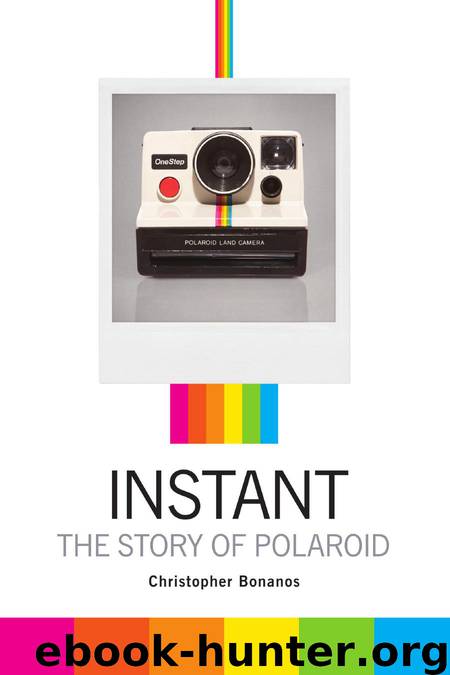Instant: The Story of Polaroid by Christopher Bonanos

Author:Christopher Bonanos [Bonanos, Christopher]
Language: eng
Format: epub
Tags: History, Photography, Art, Non-Fiction, Business, cookie429, Kat, Extratorrents
ISBN: 9781616890858
Publisher: Chronicle Books
Published: 2012-09-10T00:00:00+00:00
LUI G
L H
T I T
M A
A N
T ED E VXI S
P I
R O
E N
S S I O N
107
Marie Cosindas, Ansel Adams,
and Bill McCune pose at a
Polaroid reception.
108
I N S T A N T
commercials starring Candice Bergen, who explained in fastidious detail
how to focus the camera. The great demonstrator was working by proxy
this time.
What really kept Polaroid going through the crisis was its old, known
technology. Land grudgingly let Bill McCune back into the SX-70 realm,
needing his quality-control expertise, and in doing so just may have
saved the whole thing. Pack-film cameras continued to sell—more than
four million per year in this era—and Polaroid added a couple of
inexpensive models at the bottom of that line to boost income.
McCune, the pragmatist, pushed for budget versions of SX-70, with
cheaper plastics and vinyl in place of the leather. Land set himself
to, among other things, improving the film chemistry and working
on the sonar autofocus system. It turned out to be a tense but effec-
tive collaboration. A project this size needed pragmatists who were
not averse to dreaming, and dreamers who could also get things done.
Land and McCune fought, but the push-pull of their relationship had
its benefits.
Slowly, with pressure from both sides, the ship righted itself, and
by 1975 it was picking up speed. The batteries finally worked. There were
enough cameras in stores. Within a couple of years, Polaroid reached $1
billion in annual sales. SX-70 was no Edsel: It was the Ford Mustang, a
product that changed the business. Even Andy Warhol gave up his Big
Shot for one, after a little prodding from Ted Voss’s marketing group.
The recovery came just in time, too. Since the late 1960s, Eastman
Kodak had been watching the goings-on in Cambridge with a sense that
they had missed out on something—that instant photography was not a
gimmick but a major part of the future of picture-taking. Had they given it
away by making all those negatives? Polaroid had begun to hear disturbing
rumbles about Kodak’s plans: a full-on push into the instant field.
There was another project going on at Kodak in 1975, too. An engineer
named Steven Sasson had worked it up as a curio, with little expectation
that it would ever be made public. It was a new camera, built around not
a sheet of film but an electronic sensor, one that recorded its image on
magnetic tape and displayed it on a TV screen. It was no pocket camera but
a desktop hulk that looked a little like a slide projector. When he presented
Download
This site does not store any files on its server. We only index and link to content provided by other sites. Please contact the content providers to delete copyright contents if any and email us, we'll remove relevant links or contents immediately.
| Biographies | Company Profiles |
| Economic History |
Pale Blue Dot by Carl Sagan(4907)
The Rules Do Not Apply by Ariel Levy(4842)
Goodbye Paradise(3724)
Ogilvy on Advertising by David Ogilvy(3503)
Liar's Poker by Michael Lewis(3367)
Delivering Happiness by Tony Hsieh(3363)
Into Thin Air by Jon Krakauer(3307)
Purple Cow by Seth Godin(3137)
Rogue Trader by Leeson Nick(2975)
The Social Psychology of Inequality by Unknown(2935)
The Airbnb Story by Leigh Gallagher(2797)
4 - Harry Potter and the Goblet of Fire by J.K. Rowling(2650)
The Mind Map Book by Tony Buzan(2510)
Bossypants by Tina Fey(2463)
Claridge's: The Cookbook by Nail Martyn & Erickson Meredith(2359)
All the President's Men by Carl Bernstein & Bob Woodward(2325)
Six Billion Shoppers by Porter Erisman(2266)
Master of the Game by Sidney Sheldon(2240)
Alibaba by Duncan Clark(2037)
